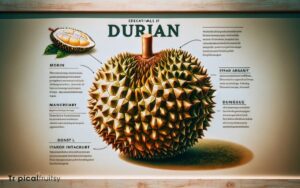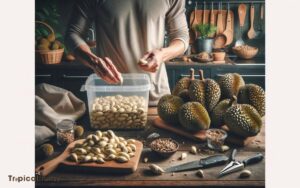What Is Durian Fruit in English? Unlocking the Mysteries!
Durian fruit, often known as the “King of Fruits,” is a tropical fruit distinguished by its large size, unique odor, and thorn-covered husk. It has a rich, custardy texture and a complex flavor that elicits mixed reactions.
Durian is native to Southeast Asia and is notorious for its strong aroma, which some people find pleasantly sweet, while others compare it to rotten onions or turpentine.
The fruit’s flesh can vary in color and is typically consumed fresh, used in sweet and savory dishes, or processed into various food products. Durian is rich in nutrients like vitamins C and B, potassium, and dietary fiber.
Here are some quick facts about durian fruit:
Despite its polarizing scent, durian remains a culinary delicacy in Asia and is enjoyed by many for its unique taste and nutritional benefits.
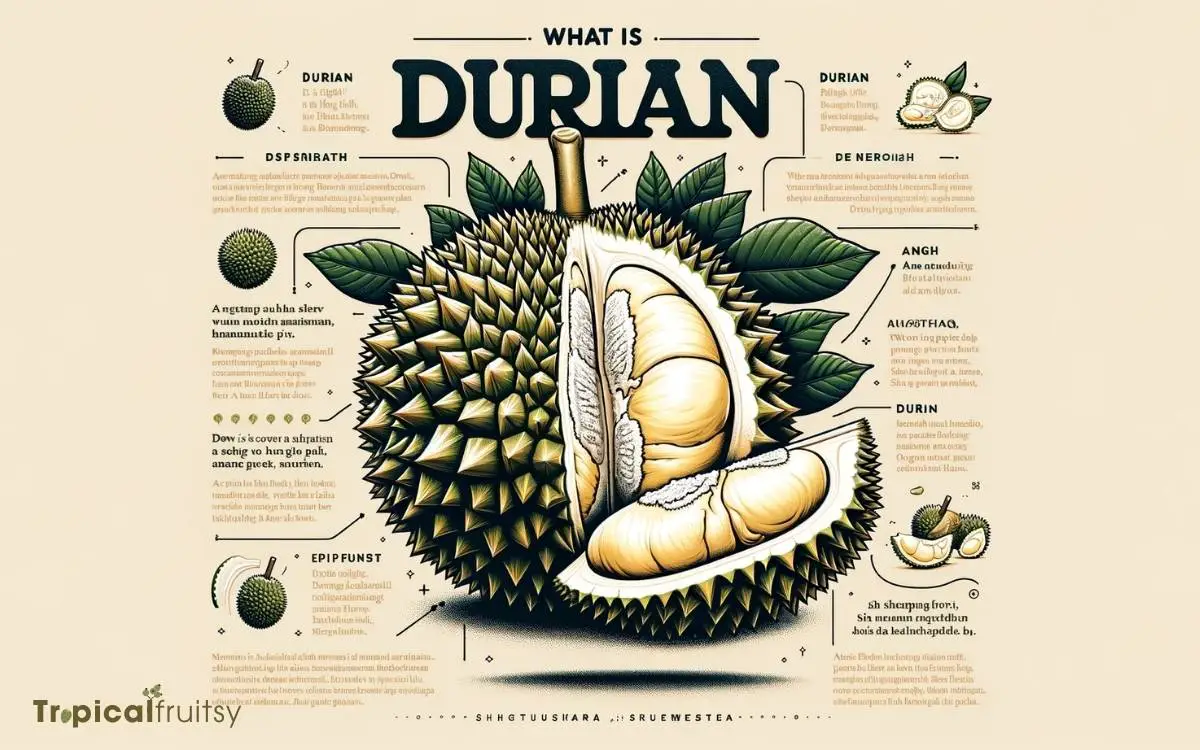
Key Takeaway
Durian: An Overview
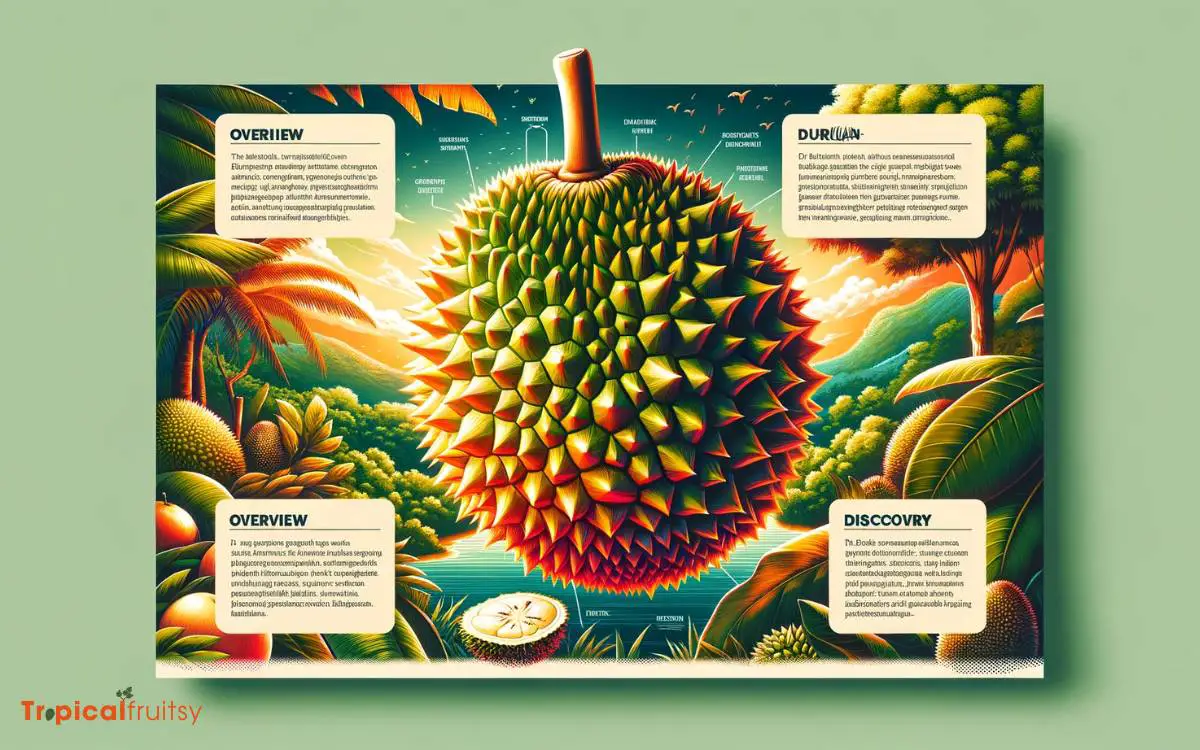
The durian is a distinctive tropical fruit known for its sizeable, spiky exterior and strong aroma. Often regarded as the ‘king of fruits,’ it is native to Southeast Asia.
The fruit’s pungent scent is infamous; some find it pleasantly sweet, while others compare it to rotten onions or turpentine.
Inside its formidable husk lies the rich, custard-like flesh. The flesh is often characterized by a complex flavor profile blending sweet and savory notes.
Despite its divisive smell, the durian’s nutritional value is noteworthy. It is packed with vitamins, minerals, and dietary fiber.
The durian is a polarizing delicacy, banned from certain public spaces due to its overpowering smell. However, it is revered by many for its unique taste and purported health benefits.
For culinary adventurers and locals alike, durian symbolizes a cultural and gastronomic experience that is both challenging and rewarding.
The Origin of Durian

Biodiversity Hotspot: Southeast Asia’s rainforests provided the ideal conditions for the evolution of the durian.
Cultural Significance: Early records and folklore indicate the durian’s prominence in Southeast Asian societies.
Trade and Cultivation: Historical trade routes facilitated the spread of durian cultivation and popularity.
Genetic Diversity: Wild durian varieties reflect a long history of adaptation and natural selection in diverse environments.
Physical Characteristics
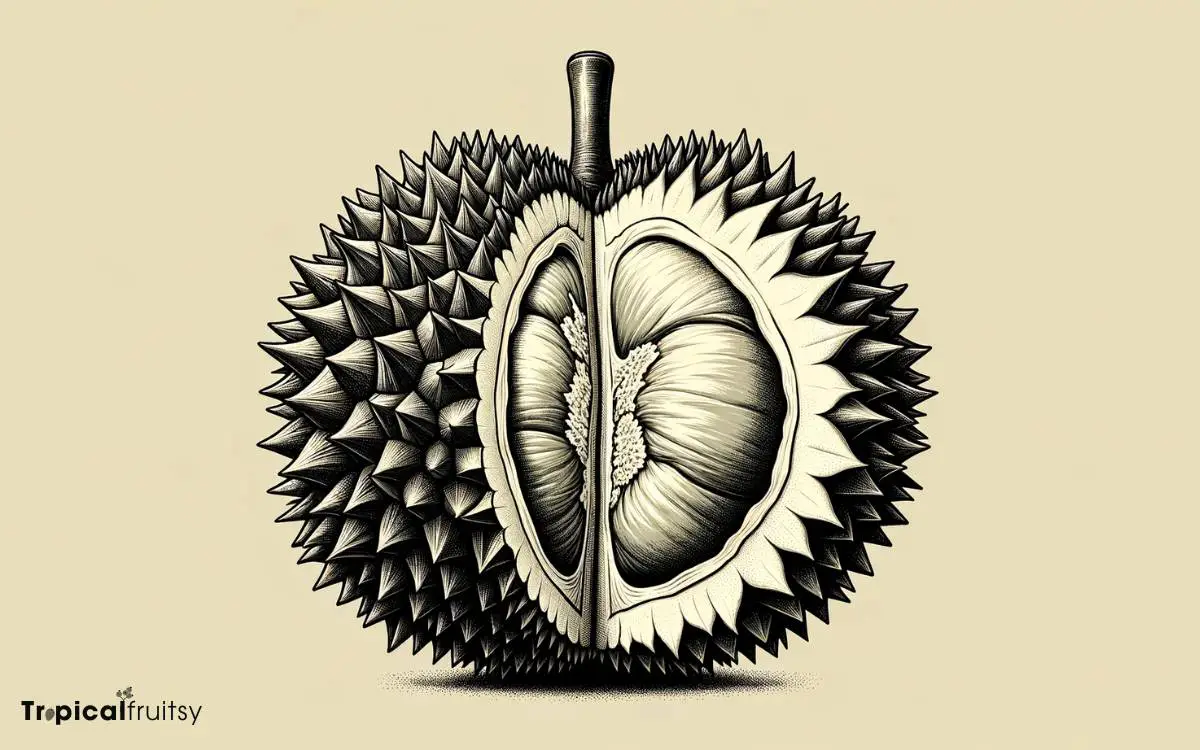
The durian fruit is instantly recognizable by its formidable, spiky outer shell, which encases the edible flesh within. This protective layer is a hallmark of the fruit, presenting a challenge to those unfamiliar with its handling.
Within this natural armor lies the soft, creamy flesh, whose complex texture contrasts starkly with the harsh exterior.
Spiky Outer Shell
Characterized by its formidable spiky outer shell, durian fruit presents a unique challenge for those unfamiliar with its handling. The shell is not only distinctive but also serves as a natural defense, protecting the soft flesh inside from predators.
Here are key aspects of the durian’s spiky shell:
- Hardness: The shell is rigid and robust, requiring considerable force or a sharp tool to breach.
- Spikes: Covered in conical spikes, the shell can cause discomfort or even injury if not handled carefully.
- Thickness: It varies in thickness, generally being thicker towards the base of the fruit.
- Color: The shell’s hue ranges from a green to brownish shade, depending on the species and ripeness.
As we delve deeper into the durian’s characteristics, let us now consider the texture of its enigmatic flesh.
Flesh Texture
While the durian’s exterior is notoriously tough, the interior flesh is soft, creamy, and custard-like, contrasting sharply with the hard, spiky shell. This juxtaposition is a sensory surprise that delights and intrigues many fruit aficionados.
The flesh’s texture, akin to a rich mousse, can evoke a deeply emotional response, as it melts effortlessly on the tongue, leaving a complex flavor profile that lingers.
| Sensation | Description |
|---|---|
| Softness | Yields gently to the slightest touch |
| Creaminess | Smooth, enveloping the palate |
| Richness | Dense, akin to luxurious cream |
| Indulgence | Evokes a sense of culinary delight |
The durian’s flesh, with its unique textural qualities, stands as a testament to nature’s ability to create diverse and unexpected experiences within the realms of taste and touch.
The Infamous Aroma

Moving beyond the durian’s formidable exterior, one encounters its most notorious attribute: the aroma.
This scent, often described as a pungent blend reminiscent of overripe fruit and aged cheese, polarizes individuals, being either deeply off-putting or strangely appealing.
The distinctive odor plays a critical role in shaping the fruit’s flavor profile, an interplay that intrigues the palate of many adventurous food enthusiasts.
Smell: Repulsive or Alluring
How does one describe the distinctive scent of durian fruit that divides opinion into extremes of repulsion and fascination?
The aroma is pungent and pervasive, often compared to a mix of savory and sweet with an underlying intensity that can linger.
To add depth to our understanding, consider the following descriptions:
- Sulfurous: Reminiscent of rotten eggs, the sulfur compounds in durian give it a distinctively sharp smell.
- Sweet: For some, hints of almond and ripe banana exude a pleasantly sweet fragrance.
- Creamy: The flesh of the fruit emits a rich, custardy odor that conveys its creamy texture.
- Decaying: Detractors liken the smell to rotting meat or onions, conveying its divisive nature.
For enthusiasts, the scent is an appetizing prelude to its rich flavor, while for others, it’s a hurdle to enjoying the fruit’s taste.
Odor Impact on Taste
The notorious aroma of durian fruit significantly influences its perceived taste, often enhancing or detracting from the overall sensory experience.
This tropical delicacy emits a pungent scent that can overwhelm the uninitiated, with comparisons to a range of odors from ripe cheese to onions.
For enthusiasts, the complex bouquet is an integral part of the durian’s allure, intertwining with its rich custardy flavor to create a unique gastronomic delight. Conversely, for detractors, the smell is so off-putting that it can render the fruit inedible.
This dichotomy highlights the subjective nature of taste and the powerful role aroma plays in shaping our food preferences.
Understanding this interplay prepares us to delve deeper into the durian flavor profile, a topic ripe with nuances.
Durian Flavor Profile

Regarding its flavor profile, durian fruit is known for its unique and polarizing combination of sweet, custard-like taste and strong, sometimes unpleasant odor.
The taste of durian has been described in various ways, reflecting its complexity:
- Richly Sweet: The flesh of the durian can be intensely sweet, often compared to a creamy dessert.
- Almond-like Hints: Some people detect a nutty flavor, similar to almonds, embedded within the sweetness.
- Complex Savory Notes: Beyond the sweetness, there are layers of savory tastes that can resemble cheese or onion, adding to its distinctive profile.
- Textural Contrast: The custard-like texture contrasts with occasional firm pieces, providing a unique mouthfeel that accompanies the multifaceted taste.
For those who appreciate its taste, durian is a delicacy that offers a remarkable sensory experience.
Nutritional Benefits
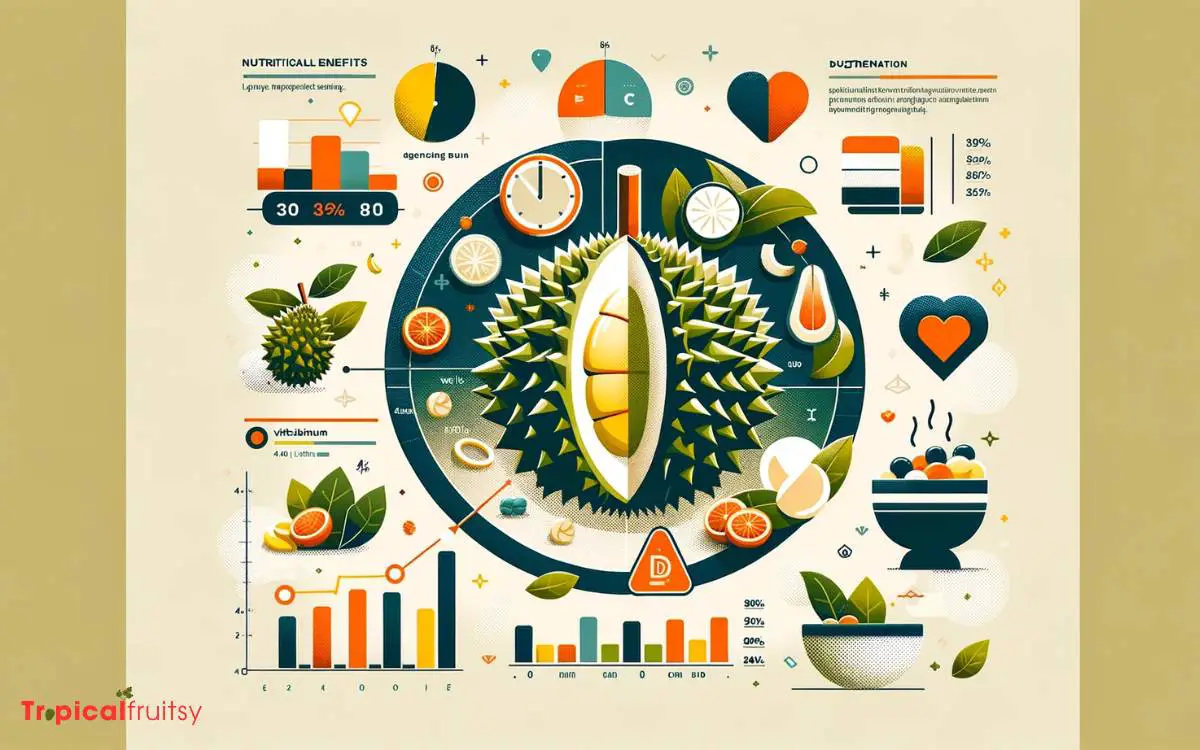
Boasting a rich profile of vitamins and minerals, durian fruit offers significant nutritional benefits, including high levels of vitamin C, potassium, and dietary fiber.
This tropical delicacy, often referred to as the ‘King of Fruits’, is not only revered for its unique taste but also for its impressive health credentials.
The presence of B-vitamins in durian, such as thiamin and riboflavin, supports metabolic health and energy production. Its antioxidant properties help to combat oxidative stress, contributing to overall well-being.
| Nutrient | Benefit | Amount per 100g |
|---|---|---|
| Vitamin C | Supports immune system, skin health | 19.7 mg |
| Potassium | Regulates fluid balance, heart health | 436 mg |
| Dietary Fiber | Aids digestion, promotes satiety | 3.8 g |
| B-Vitamins | Enhances metabolism, energy levels | Varied |
Durian’s rich nutritional tapestry underscores its value as a food that is as nourishing as it is flavorful, making it a noteworthy addition to a diverse and health-conscious diet.
Culinary Uses Worldwide
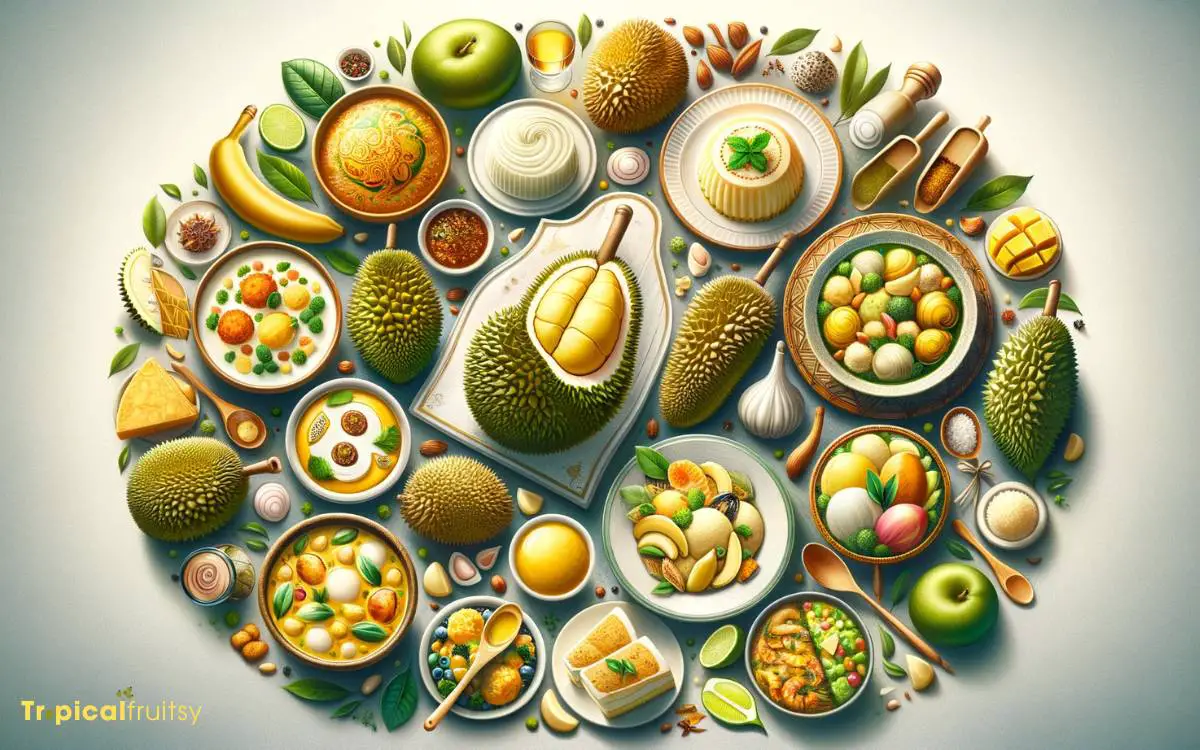
Beyond its nutritional value, durian fruit is incorporated into a myriad of culinary traditions around the globe, reflecting its versatility in both sweet and savory dishes.
The potent aroma of durian may be polarizing, but its rich custard-like texture and complex flavor profile make it a unique ingredient in various cuisines.
Here are several ways durian is used across the world:
- Southeast Asia: Durian is often eaten fresh, paired with sticky rice, or used in traditional desserts like serawa durian and cendol.
- Ice Cream & Pastries: Innovative chefs craft durian-flavored ice creams, cakes, and pastries, embracing its creamy consistency.
- Savory Creations: In some cultures, durian is incorporated into savory dishes, such as curries and side dishes, adding a distinctive taste.
- Beverages: Durian smoothies and milkshakes are popular refreshments that highlight the fruit’s sweet, velvety flavor.
Cultural Significance
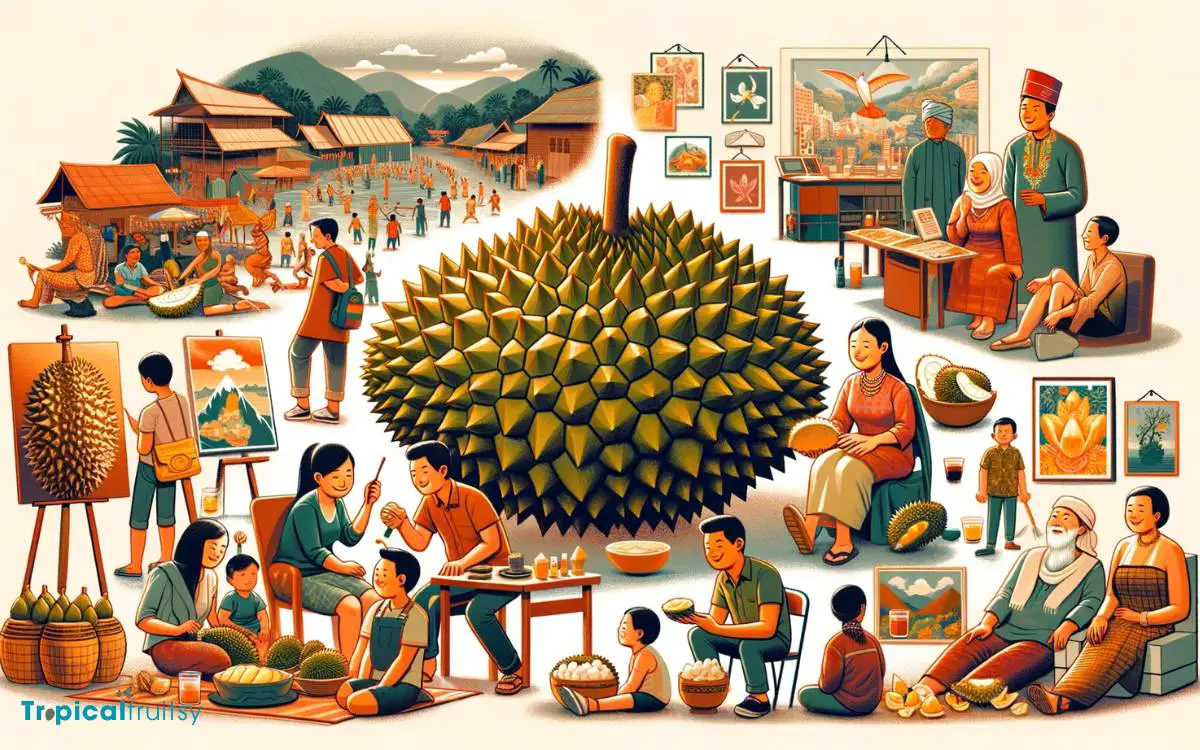
Durian consumption transcends mere taste preferences, embodying deep-rooted cultural traditions and social practices in many Southeast Asian societies.
Known as the ‘King of Fruits,’ durian holds a place of honor in events and gatherings, symbolizing wealth, social status, and group identity.
Its distinctive aroma and flavor profile have inspired a myriad of regional festivals, where communities celebrate the fruit’s season with enthusiasm and fanfare.
The act of sharing durian fosters a sense of camaraderie and belonging, as it is often enjoyed in groups, with each person partaking in the communal experience.
For many, durian is not just a fruit but a cultural icon, representing the rich tapestry of traditions that define and enrich the heritage of Southeast Asian nations.
Handling and Storage Tips
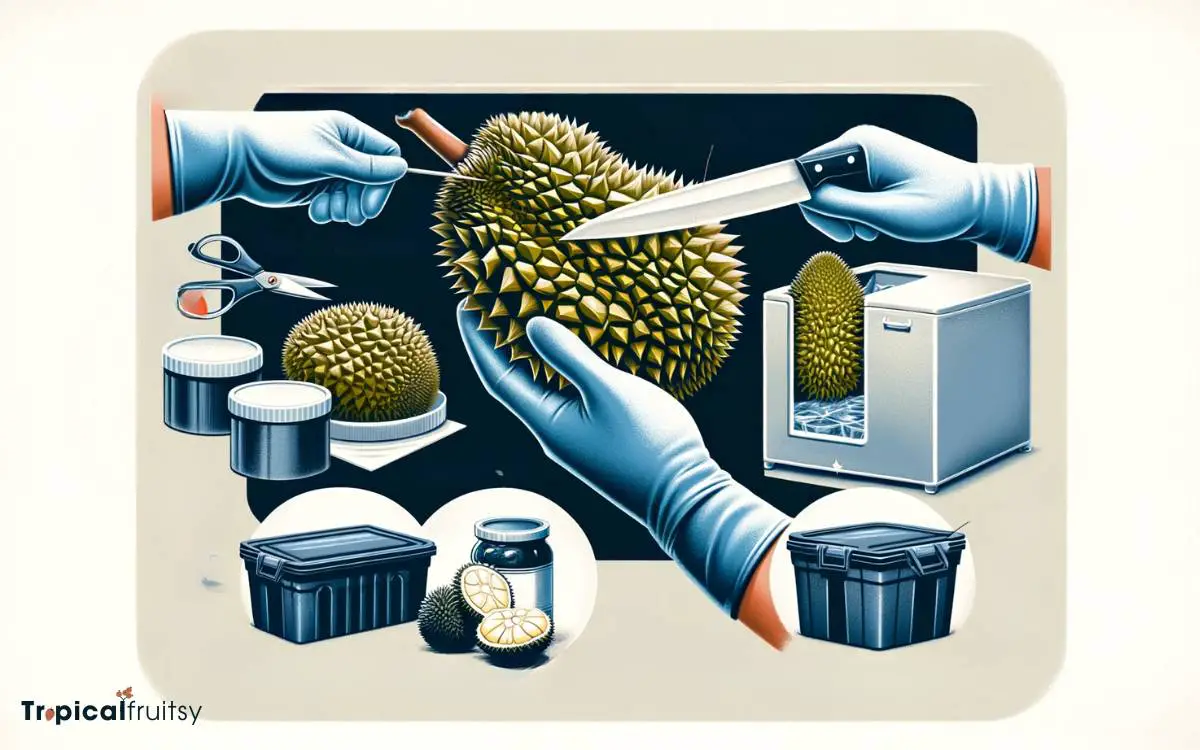
To maintain the revered status of this cultural icon, proper handling and storage of durian are essential to preserve its quality and distinctive characteristics.
For enthusiasts eager to enjoy the fruit at its peak, consider the following guidelines:
- Select Wisely: Opt for intact durians without cracks or holes. The stem should be firm, indicating freshness.
- Temperature Control: Store durians at room temperature if consuming soon, or refrigerate for short-term storage to slow ripening.
- Airtight Sealing: When refrigerated, seal durians in airtight containers to prevent odor transfer to other foods.
- Freezing for Longevity: For long-term preservation, freeze durian flesh in sealed bags, ensuring its exotic flavor endures for months.
These practices will help you savor the essence of durian without compromising its unique profile.
Conclusion
The durian stands as a culinary paradox, its divisive nature reminiscent of a monarch whose reign elicits both reverence and dissent.
This ‘king of fruits’ harbors a wealth of nutritional benefits beneath its formidable armor, offering a unique flavor that has traversed cultural boundaries.
For enthusiasts and the culinary adventurous, proper handling and storage of durian ensures the enjoyment of its rich tapestry of tastes, contributing to its esteemed status in diverse gastronomic traditions.

